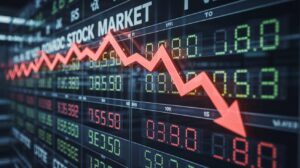The slowdown in small business growth is raising red flags for the U.S. economy, signaling potential economic challenges ahead. Recent data reveals that small businesses across the country are struggling with declining revenues, increased debts, and stagnating employment rates. If these trends persist, they could significantly impact job creation and economic stability.
Understanding the Current State of Small Businesses in the U.S.
Small businesses are the backbone of the U.S. economy, contributing 43% to the nation’s GDP and employing nearly half of the American workforce. However, recent surveys show that small businesses are facing unprecedented financial stress:
| Key Metric | 2023 | 2024 | 2025 (Projected) |
|---|---|---|---|
| Businesses Reporting Profitability | 55% | 50% | 46% |
| Businesses Operating at a Loss | 28% | 32% | 35% |
| Small Business Confidence Index | 62 | 58 | 51 |
These numbers indicate a worrying trend where fewer businesses are profitable, and confidence among small business owners is declining.
Key Factors Contributing to the Decline
- Rising Costs: Inflation has driven up the prices of raw materials, rent, and labor, squeezing profit margins for small businesses.
- Tariffs & Trade Policies: Increased tariffs on imports have made it more expensive for small businesses to acquire essential goods and materials.
- Economic Uncertainty: Unpredictable government policies, interest rate hikes, and banking instability have made small businesses hesitant to expand.
How the Stagnation of Small Business Growth Affects the Economy
When small businesses struggle, the entire economy feels the impact. Here’s how:
- Job Market Instability: Since small businesses employ 46% of the private workforce, a slowdown can lead to job losses.
- Reduced Consumer Spending: A decline in wages and employment results in lower consumer spending, affecting large and small businesses alike.
- Lower Tax Revenue: With fewer businesses making profits, local and federal governments collect less tax revenue, affecting public services.
Small Business Decline & Its Economic Impact
Small Business Decline
|
------------------------------------------------------
| | |
Job Losses Lower Consumer Spending Less Tax Revenue
| | |
Economic Slowdown Business Closures Public Budget CutsSigns of Resilience Amid Challenges
Despite these struggles, the entrepreneurial spirit remains strong. Business formation applications increased by 7.8% in February 2025, suggesting that new businesses are still being created at a higher rate than pre-pandemic levels.
- Technology Adoption: More small businesses are shifting to digital platforms, allowing them to reach wider audiences.
- Remote Work Models: Businesses are cutting costs by operating remotely and reducing office expenses.
- Alternative Funding Sources: Crowdfunding, venture capital, and grants are becoming more accessible for small businesses.
What Can Be Done to Support Small Businesses?
Government policies and community efforts can help businesses survive and grow:
- Regulatory Reforms: Simplifying compliance requirements and reducing red tape for small business operations.
- Financial Assistance Programs: More accessible loans, grants, and subsidies can provide relief.
- Encouraging Digital Transformation: Government incentives for small businesses to adopt digital tools and e-commerce platforms.
A Look Ahead: The Future of Small Business Growth
While challenges such as rising costs and regulatory burdens persist, businesses that embrace innovation and adaptability will be better positioned to thrive.
Conclusion
The stall in small business growth is a warning sign for the U.S. economy, but not all hope is lost. By implementing the right policies, adopting new business models, and supporting entrepreneurship, small businesses can continue to drive economic growth. The coming months will be crucial in determining whether these businesses can overcome these challenges and emerge stronger than before.
[USnewsSphere.com / usc]





